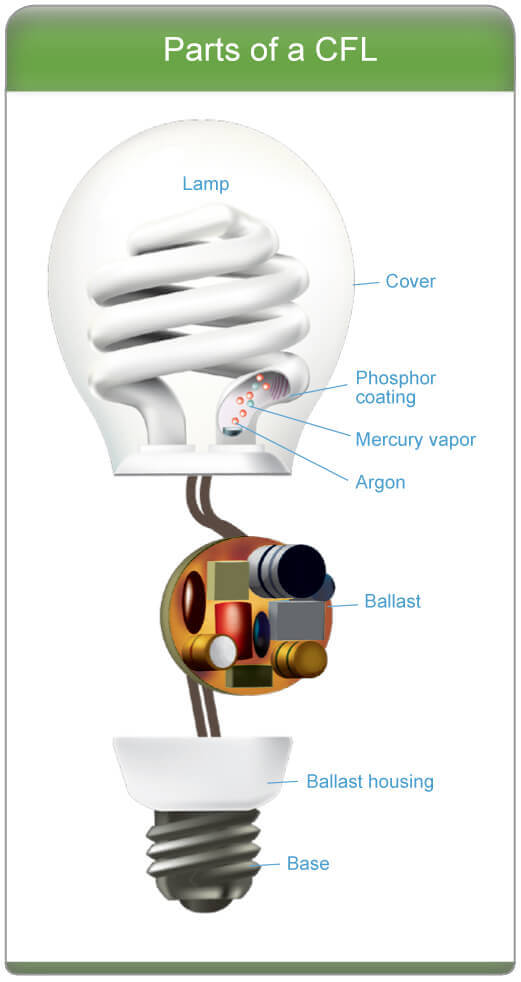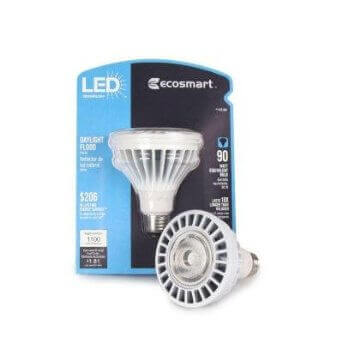Energy Efficient Light bulbs: What You Need to Know

Light bulbs: halogen incandescent, CFLs, and LEDs[/caption]
I am here to shed some light on energy efficient light bulbs. Bad pun, but seriously. There is a light bulb law that Congress and the President passed called The Energy Independence and Security Act of 2007, which requires light bulbs to be 25% more efficient than old school light bulbs, and will see these traditional bulbs phased out eventually. So, what are your light bulb options?
Incandescent. Traditional incandescent light bulbs are on their way out because apparently 90% of the energy they produced is emitted as heat -- not light -- which is wasted energy. So, now we have several choices that are energy efficient and can save you money: halogen incandescent, CFLs, and LEDs.
Halogen Incandescent Bulbs. First you have your basic halogen incandescent bulbs, which come in a variety of shapes, sizes and wattage for all your lighting needs. They have a capsule that holds halogen gas, such as iodine or bromine, around a filament to produce light energy in an efficient manner.
Compact Fluorescent Light bulbs. Known as CFLs, these are basically smaller, curly versions of those long tubes used commercially or in your garage. You'll notice that they cost more; however, because they use less energy than incandescent bulbs, they typically pay for themselves within nine months and then start to save you money. These bulbs use 1/4th the energy of old school incandescent and lasts 10 times longer! They use about 1/3 the energy of halogen incandescent bulbs.

Don't want fluorescent lighting in your house because you think it's too darn bright, a tad industrial, and not very cozy? Well, fear no more because these little rock stars come in a range of colors to suit your taste. A few years ago, I was frustrated that they only came in the curly shape and in several of my lamps, they poked out over the shade. But now they come in several different shapes and sizes.
A few things to note: Because CFLs contain small amounts of mercury, the EPA recommends that you recycle unbroken bulbs at Home Depot, Lowes, Ace Hardware, or other participating retailers. Also, because of the technology that makes these guys glow, CFLs sometimes take several minutes to emit the light that you need. And, most CFLs cannot be used with dimmer switches.
LED Light bulbs. LED stands for light emitting diode. Basically, these bulbs use semiconductors to convert energy into light. LEDs produce far less heat, but generate an equivalent amount of light for roughly 80% less energy than a traditional incandescent light bulb. LED light bulbs are more durable and last longer than any incandescent bulb because they are made out of plastic not glass.

LED Lightbulb
LEDs do cost more, but you can get some for less than $5.00 and they last anywhere from 20,000 to 50,000 hours! I had my sixth grader do the math and that means these bulbs could stay lit continuously for 2.28 to 5.70 years. Whoa. And, practically speaking, if your bulb is lit only 4 hours a day, it lasts decades!
Lumens vs. Watts. Sometimes when people talked about lumens, I found myself thinking, "Why the heck is this fancy-pants calling "watts" "lumens"??? Well, it turns out that lumens and watts are two totally separate units of measurement. Watts measure the amount of energy it takes to light a bulb, whereas lumens measure the amount of light the bulb emits. The more lumens, the brighter the bulb. Lumens are given more street cred in the lighting world, so we need to get used to them. Most of us know instinctively what kind of incandescent wattage we used for a particular lamp or fixture, so we can learn to translate it into lumens. For example, an old 40-watt incandescent bulb = 450 lumens; a 60-watt bulb = 800 lumens; a 100-watt bulb =1600 lumens.

But you don't actually have to commit that to memory because the FTC has worked with manufacturers to come up with a Lighting Facts label to help consumers. Think of a nutrition label, but for lights. It will tell you some important facts such as:
- Brightness
- Energy cost
- The bulb’s life expectancy
- Light appearance (for example, if the bulb provides “warm” or “cool” light)
- Wattage (the amount of energy the bulb uses) and
- Whether the bulb contains mercury or not
For a really cool article that lays out the pros and cons of each type of energy efficient light bulb, and analyzes how much you can save using these different bulb, read The Simpler Dollar's post called Light Bulb Showdown. Very enlightening (see what I did there?)!
The Future of Lighting? Smart LEDs. If all of this is old news to you, you probably want some information on the next big thing in lights: built-in technology all controlled with an app from your smartphone. Capabilities such as programmable timers, ability to mimic dawn and dusk light, and remote access to all lights using these light bulbs make them convenient and "the next big thing." These smart lights still cost $15+ a pop and require a kit to install the app. Having just wrapped my head around the basics, I'll save the topic of Smart LEDs for a future post.
By Bridget Gorman Wendling
Have something to add? Comment below to share your thoughts.
Recent Posts
-
Incorporating the Benjamin Moore Color Trends 2020 Palette into Your Home
How to Incorporate the Benjamin Moore Color Trends 2020 Palette into Your HomeEach year, Benjamin M …Jul 29th 2020 -
The Most Common Cabinet Repair Problems and How To Fix Them
Repair work is a big part of cabinet making and, if you’re into DIY, it’s a great place for you to s …Mar 13th 2017 -
10 Pegboard Ideas for the Creative Organizer
A beautiful and unique pegboard table runner from WandeleurPegboards could certainly be describ …Feb 2nd 2017

